🔗 Trust Box (Gallery): https://heya.world/trust_box
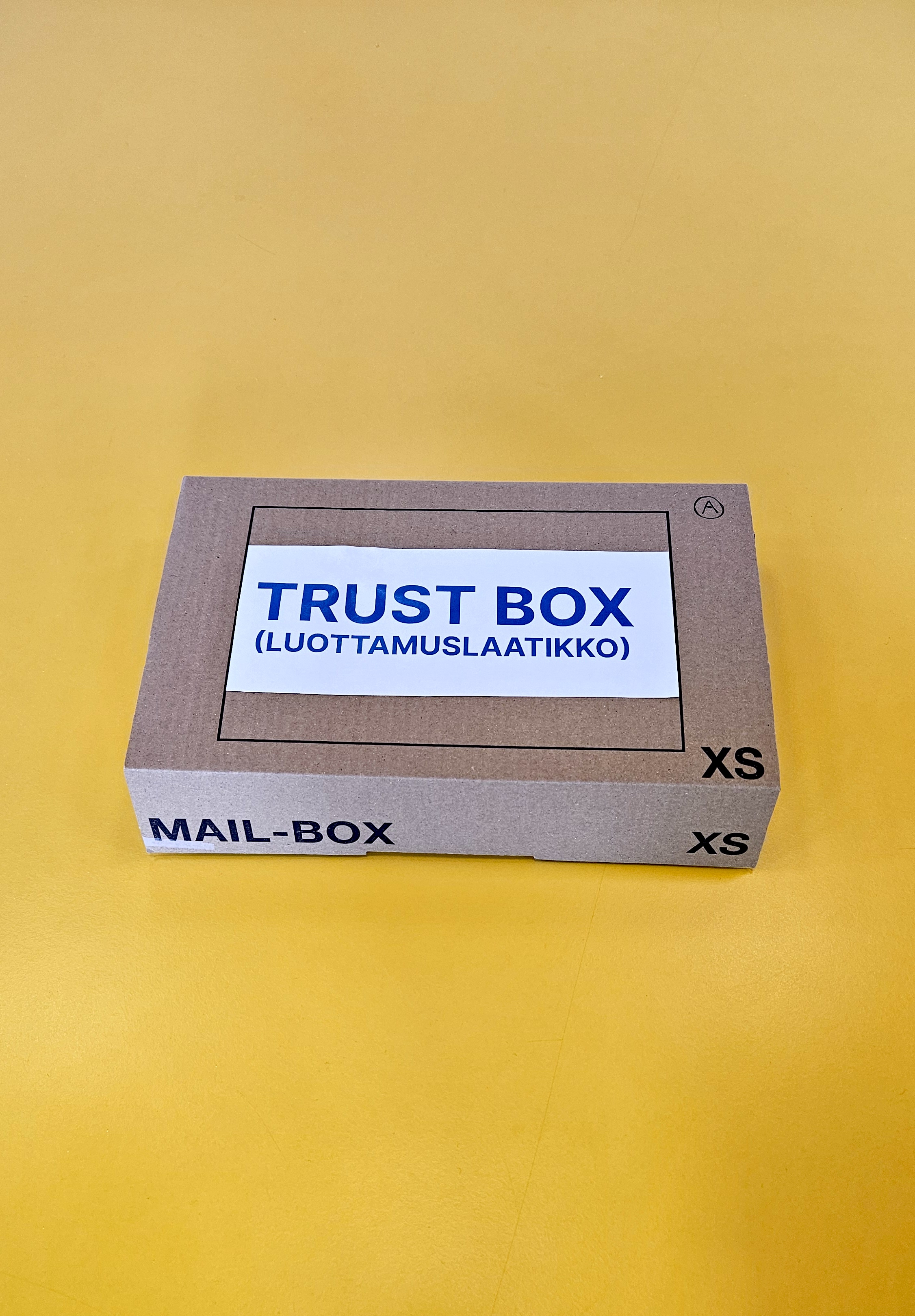
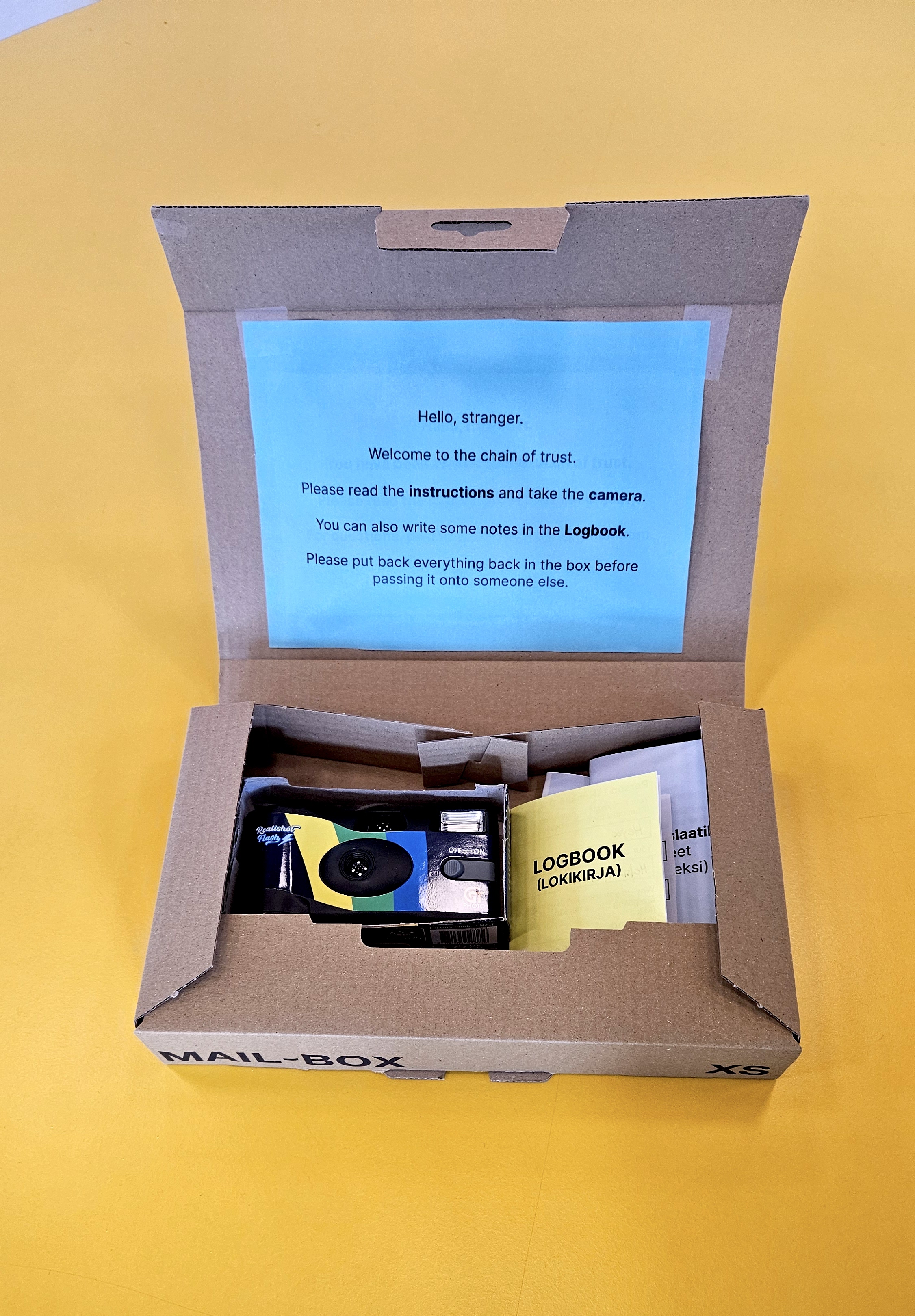
Each Trust Box consisted of a diposable camera (with 27 exposures), two instruction booklets (one in English, one in Finnish), and a logbook where participants can share their name, location, and why they trust the next person in the chain.
Introduction
What does trust look like?
Trust is not something easily visualized. It doesn't even have a universally recognized symbol like how peace and love does. Yet it is so important for the well-being of individuals and the fabric of communities. Imagine a world without trust. What kind of society would we build? What kind of relationships could we keep? And what kind of hopes would we have to live on? In this project, I use five sets of disposable cameras and logbooks as tools to explore what trust might look like in Finland.
The project draws loose inspiration from “six degrees of separation” theory that all people are six or fewer social connections apart. One of the early conceptions of this theory was Stanley Milgram’s 1967 “small world” experiment that aimed to find the average social distance between two people. In the study, participants in the United States were asked to send a letter through their personal network to reach a target person in another city. While some chains were completed, most failed: in the most famous case, 232 out of 296 never reached the destination. However, out of the 64 letters that did reach the target city, the average path length fell around five and a half or six.
With Trust Box, I wanted to create a similar chain--one based not just on random connections, but on trust. Thus, I decided to ask each participant to choose someone they trust to be the next link. I also asked each person to take a photo that describes why they trust the next person. I was curious what the result would be. Would people continue something simply because they were entrusted to do so? What kind of images might appear to represent trust? And what would be my connection to the third, fourth, or even eighth person in the chain?
Relying on fragile, analog tools and in-person interactions, Trust Box is both a social experiment powered by trust and a visual archive of the relationships that sustain it.
This project was created during and funded by Aalto University’s Art + Media Studio (Interactive and Participatory Art).
Note about Finland
As probably not all the readers are familiar with Finland--the country I'm currently based in--and since this work is rooted in Finland, I would like to share some context about the location.
Finland is often considered one of the most honest and reliable countries in the world. In the "lost wallet" experiment conducted by Reader’s Digest, Helsinki ranked as the most honest city, with 11 out of 12 wallets returned. This aligned with my own experience as well. I once accidentally left my phone on the Helsinki metro, and it was so promptly and kindly returned to me in the next 30 minutes. I also often notice people leaving their laptops and other personal belongings in their café seats while they order or use the bathroom.
But at the same time, Finland has its struggles with loneliness; it consistently ranks among the top in Europe for social isolation. According to a 2025 report by the Finnish Red Cross, 59% of people in Finland feel lonely at least occasionally, and one in four have been feeling lonely for over five years. When I asked my Finnish friends about this, they confirmed that social isolation is a big issue in Finland and that there is a need for more grassroot communities.
In my own experience of Finland, I also witnessed a culture of independence and solitude -- keeping to oneself and not asking for help -- as a way not to burden others. (Of course, this is a generalization and not everyone is like this. Also, my experience with Finland so far is limited to cities like Helsinki, Espoo, and Tampere. But again, my Finnish friends agreed that many share this culture.)
I thought it would be interesting to work on this project in Finland because it has both a high level of public trust (which means there is a higher chance of me retrieving at least some of the boxes safely) and a need more intimate in-person and trust-based interactions. It was my hope that this project can not only explore the theme of trust but also spark interesting and intimate connections for some.
The Process

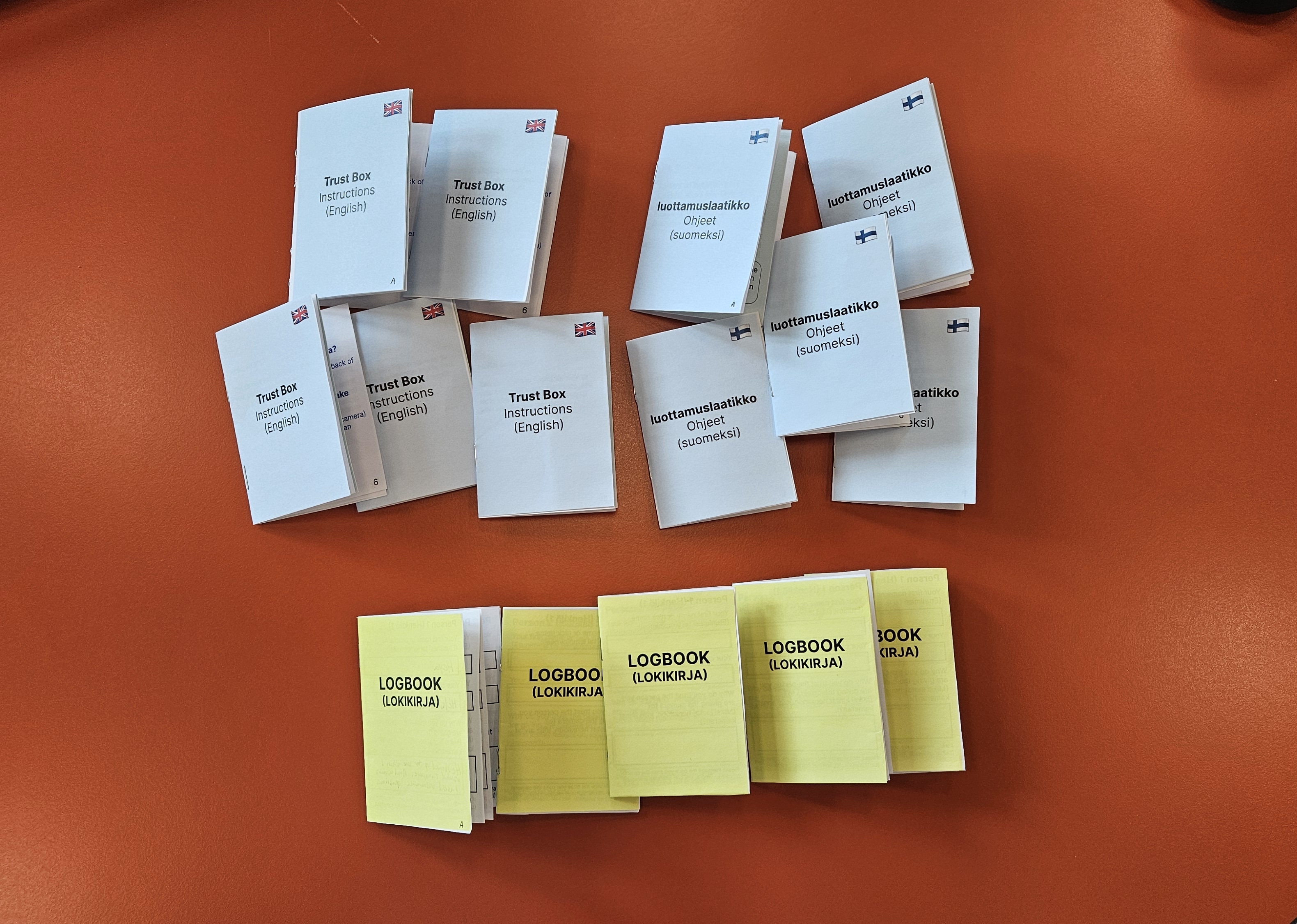
Left: Process of making the trust box; Right: All the instruction booklets and logbooks.
So here’s how this project went: I bought five disposable cameras and put each in a small mail box labeled “Trust Box.” Along with a camera, I included two copies of an instruction booklet (in English and Finnish) and a logbook in each box.
I handed each Trust Box to someone I personally trust. I asked each of the "trustees" to take three photos — one about the person who gave them the box (me), one about themself, and one about the person they would pass it on to. Then, as the instructions suggested, I asked them to sign the logbook and pass the box to someone they trust, in person.
Each camera can hold 27 exposures, meaning it would ideally pass through nine people total, connected by a chain of trust. In the instruction booklet, I asked the last person in the chain to send me a message so that I can retrieve the boxes.
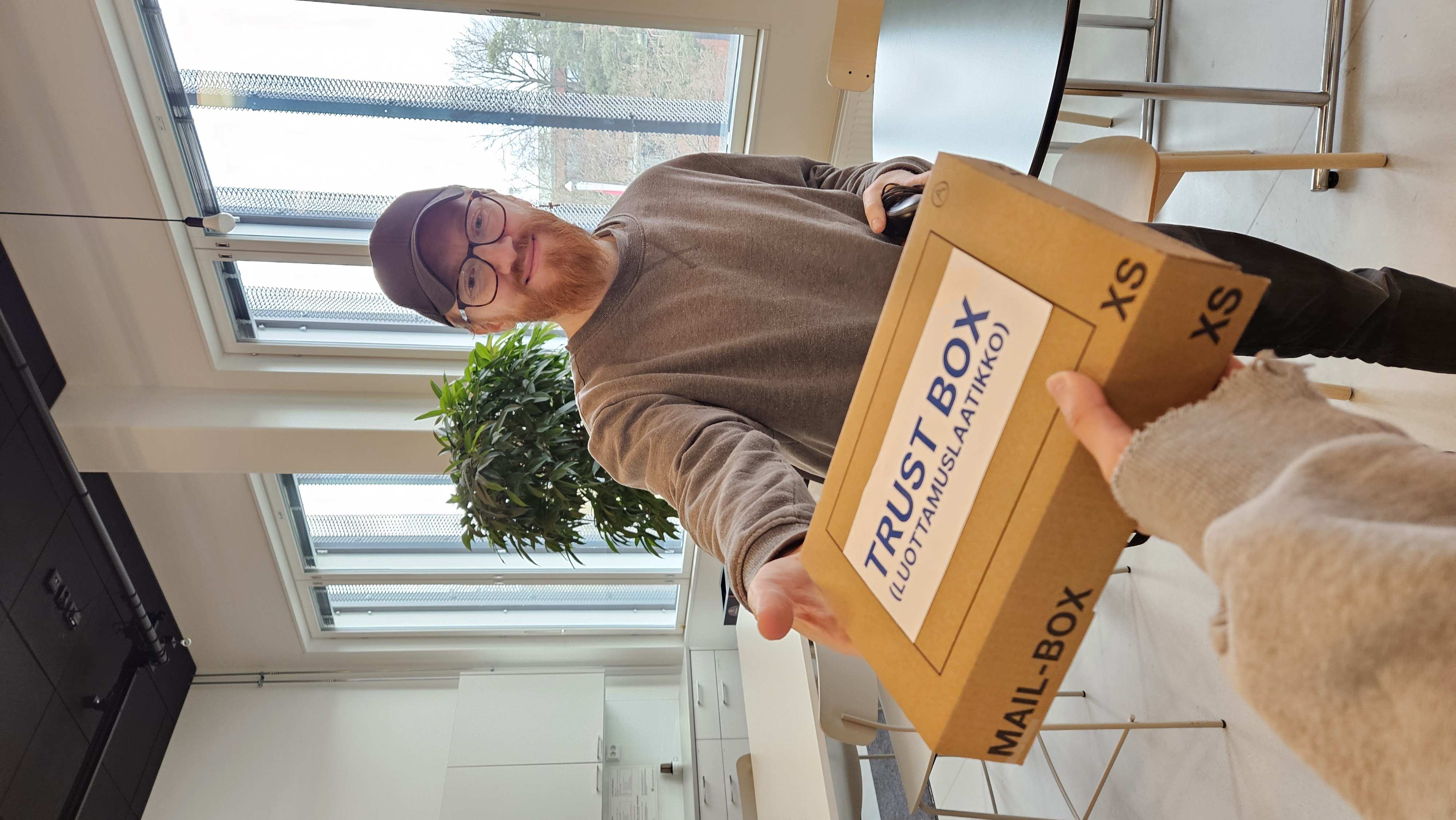
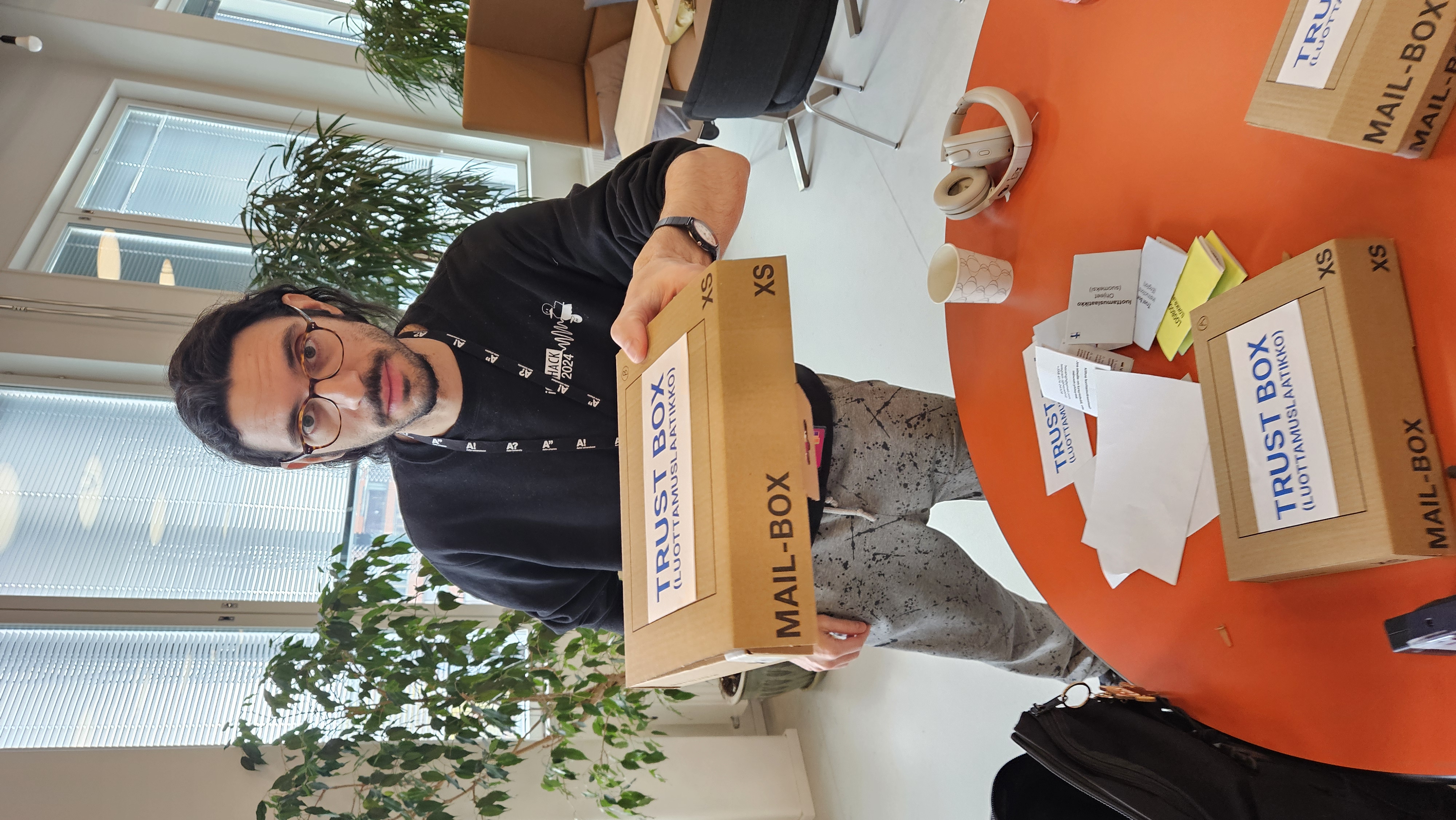

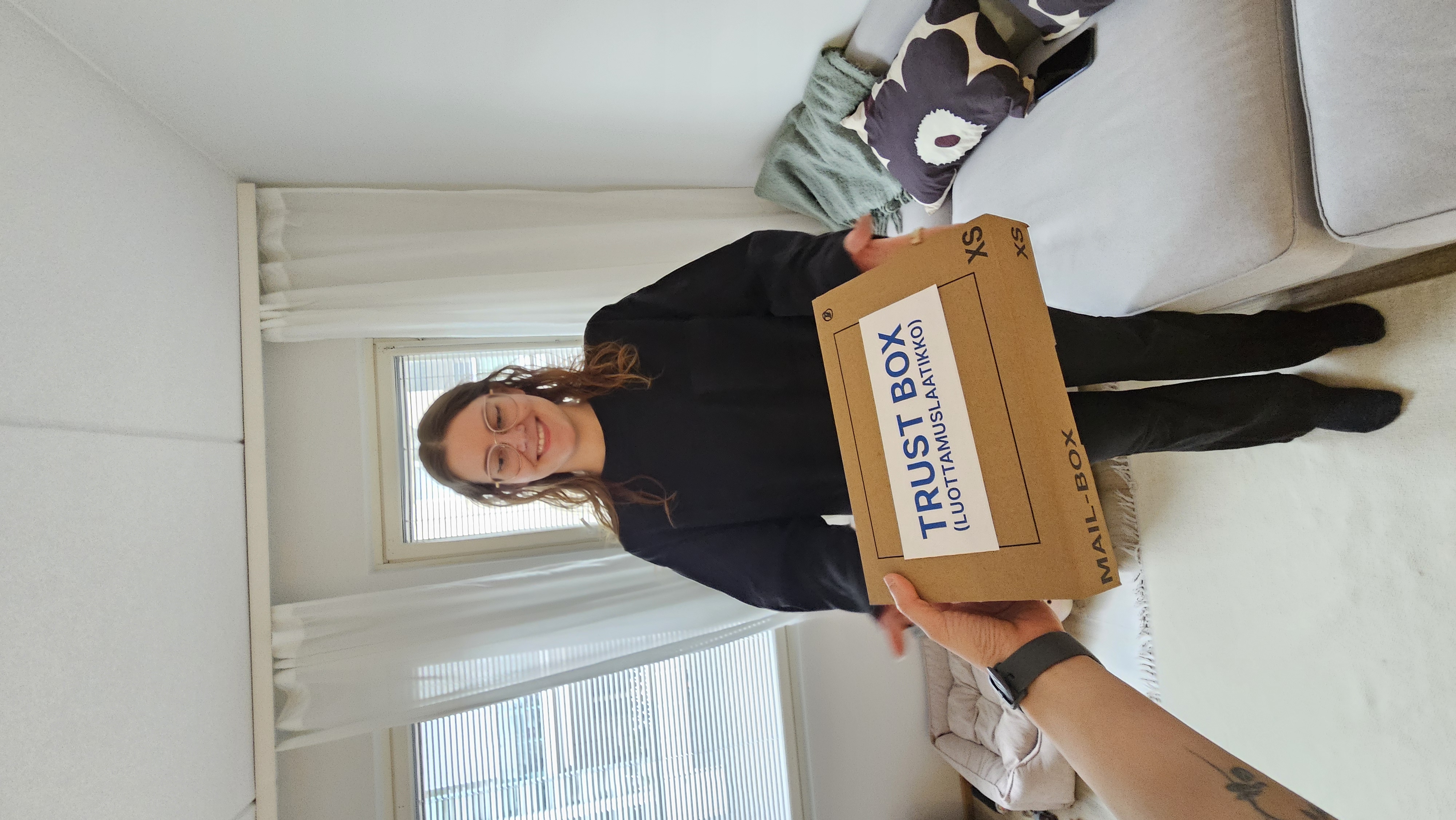
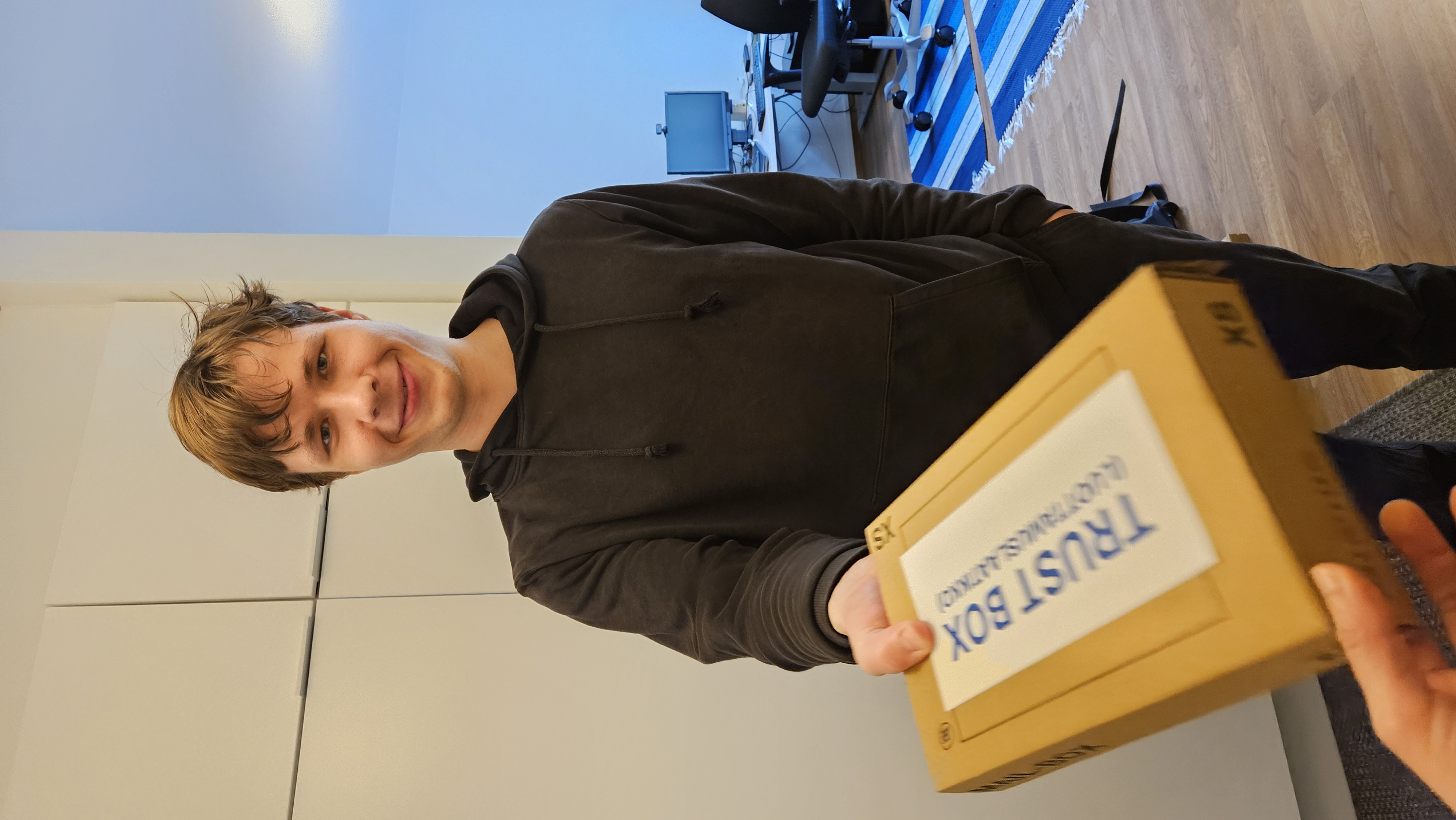
The five people whom I personally handed the box to.
Of course, there were risks. At any point in the chain, a camera could be lost, forgotten, or rejected. While I trusted the person I gave the camera to--and maybe even the person they would pass it to--how could I be sure about the fourth, fifth, or ninth person in line? They would likely be complete strangers to me. I couldn’t imagine what they look like, so how can I say I really trust them?
But still, those people are not truly random strangers. I am connected to each of them through an intimate, intentional thread built entirely on trust. So, despite my trust issues and anxieties, I chose to follow through. And even if this experiment failed and I am not able to retreive any of the boxes, I would still have learned something about trust.
Instructions
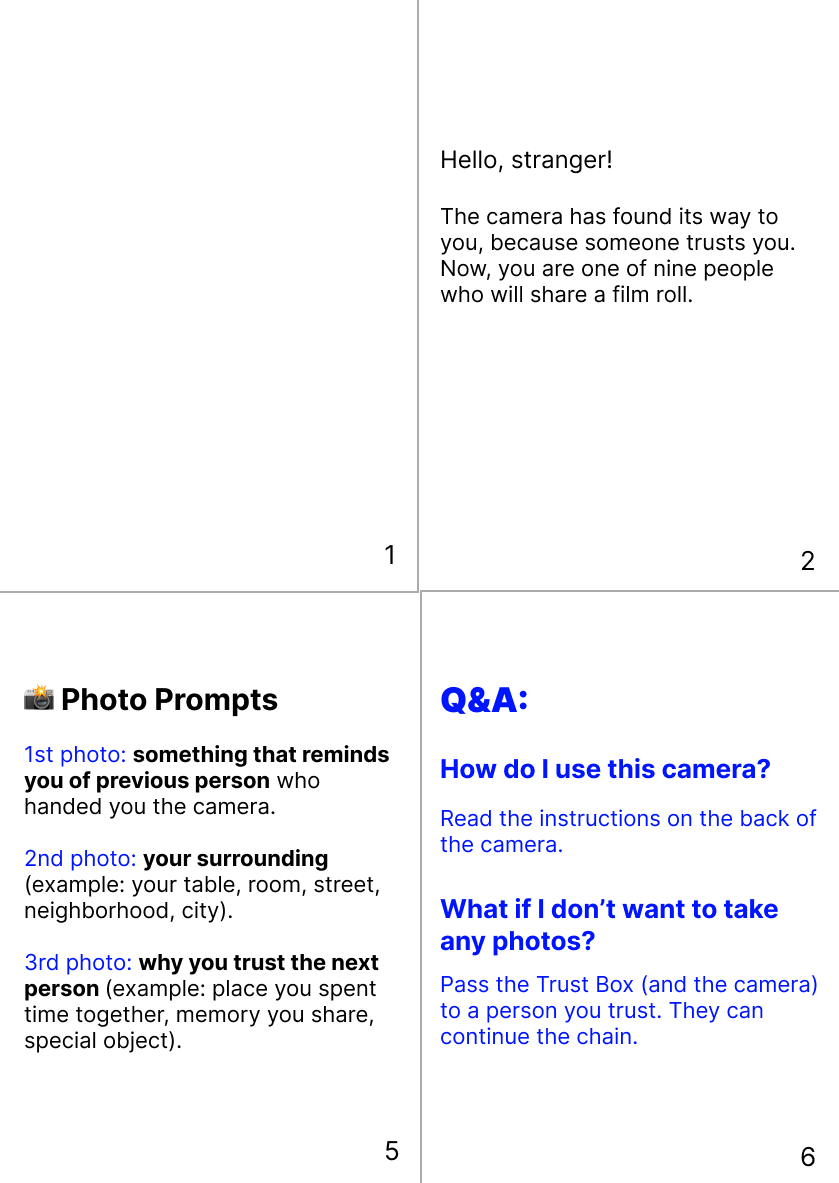
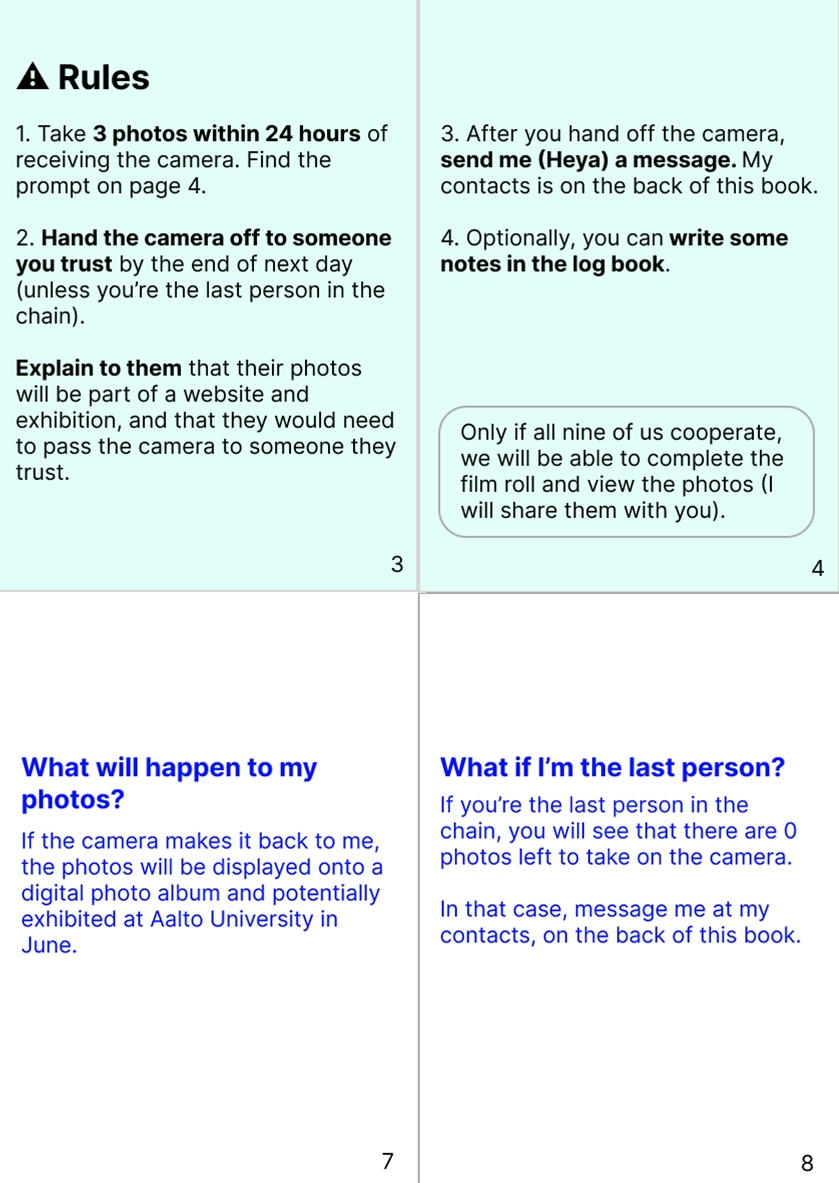
Some pages from the instruction booklets (English version).
The Results

Photo #16 from Trust Box #1. Thank you to the stranger who took this amazing photo and to the fantastic model as well.
The results were both unexpected and heartwarming. Out of the five boxes I distributed, four were completed and returned within a matter of weeks. The final participants in each chain reached out to me (using the contact info I left in the box), and I was able to retrieve the boxes in person. And meeting each of them was deeply rewarding.
Each “last person” in the chain was unique: one was a bachelor’s student in Espoo; another, a human rights NGO worker in East Helsinki; third was a father in a family of eight living in Vihti (I picked up the box from his brother, due to distance issue); and the last person was a midwife in Tampere, just heading into her first night shift. All of them, in their own way, were so kind, genuine, and supportive. My conversations with each of them, albeit short, felt special and moving.
Dare I even say, this project restored a bit of my faith in humanity.
Once I retrieved the four boxes, I got the photos developed, printed, and scanned at Fotoyks Kamppi. It was exciting to wait for the development to complete. At the same time, I have to admit that I was nervous not knowing what the photos were going to look like. I guess this is the beauty of a film camera: it involves risk and waiting.
I was so delighted to see the developed photos. Each roll captured the journey of the camera through the lens of the trusted (and trusting) partcipants. Even the dark and underexposed photos were charming, and the random objects captured sparked my curiosity. Without knowing any details other than notes left in the logbooks, my mind naturally imagined a story for each photo. And most of these photos will remain a mystery to me and you.
The resulting photos that you can see here are snapshots of daily life across Finland. Individually, or without context, they might look quite random or insignificant. But taken together, they form an emergent, communal archive of trust. The scanned handwritten notes from the logbooks add another layer of context.
Update: I just heard back that the one missing box (Box #4) is completed as well, so I was able to pick it up. Would you believe me if I said it ended up in Sweden, where a two-and-half year old baby participated in the chain? The photos from this box will be developed and uploaded to be included in the gallery as well.
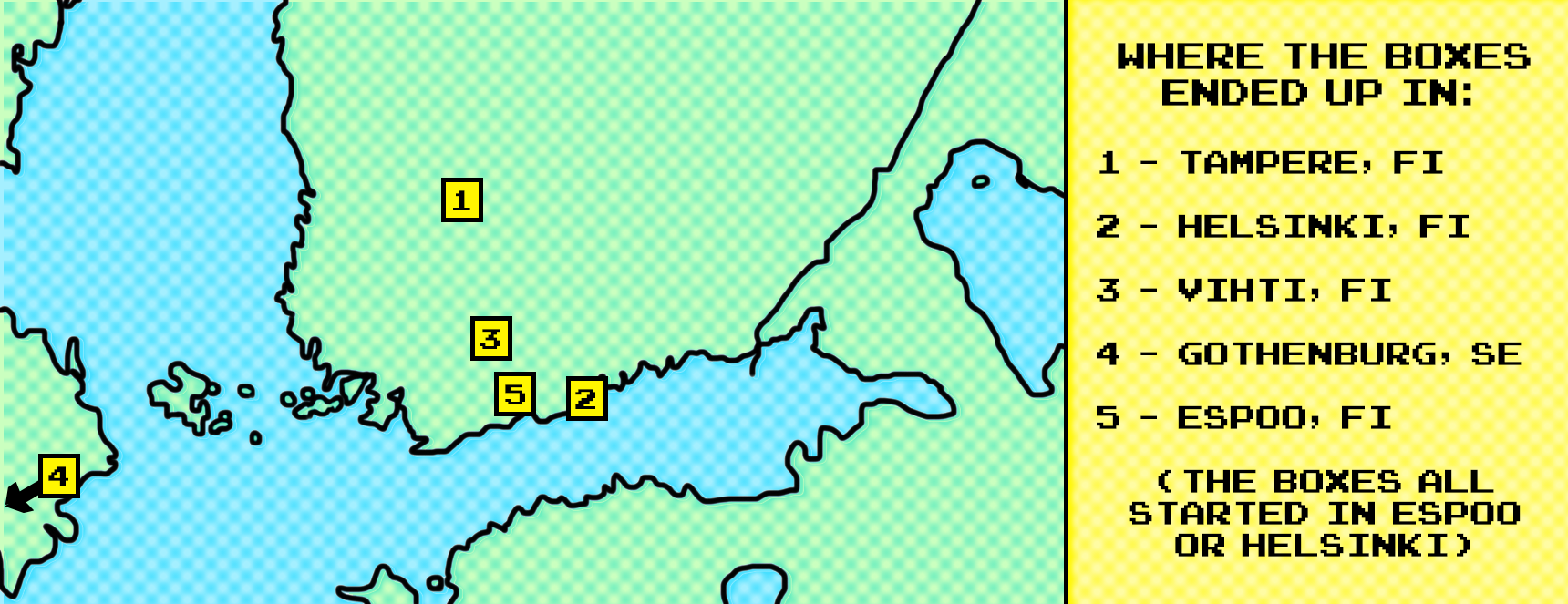
Where each of the five Trust Boxes ended up in: Tampere, Helsinki, Vihti, Örebro, and Espoo.
Highlights
Here are just a few highlights from each box. But the rest are really interesting too. To see all the photos and logbooks, be sure to check out the trust box gallery here.
Box 1 (Espoo → Tampere)
I really enjoyed reading the logbook from this box. There were some creative answers that included fun sketches and imageries.



Logbook scans of person 2, 3, and 6. "Exquisite mustache" is a great reason to trust someone.



Very cool portraits taken in Tampere, from Trust Box #2.
Box 2 (Espoo → Helsinki)
Seeing these logbook notes in Finnish made me excited me because (1) I've been learning Finnish and it makes me happy to see some in this project, (2) it made me realize that the box reached outside of my international bubble, and (3) it confirmed that it was worthwhile to include instructions in Finnish.



Logbook scans of person 6, 7, and 8. These were the only logs written in Finnish out of the 5 Trust Boxes.


Mysterious photos from this box. My mind starts to form a story seeing these photos without context.
Box 3 (Helsinki → Vihti)
Box 3 must be full of athletic people. I actually gave this box to a friend I made at a climbing gym. Although I've only seen him a handful of times and never hung out outside the gym, there was something about him that I could trust. I'm so glad that I gave the camera to him.


Left: an exterior of a climbing gym; Right: some kind of running event?


Left: squash practice room; Right: a badminton racquet plus an 2009 Olympics hoodie
Box 4 (Helsinki → Örebro, Sweden)
This box has travelled far. Starting from Helsinki, it has gone to Espoo, Rauma, Örebro (Sweden), and back.


Photos taken by a 2.5 years old human!
Box 5 (Helsinki → Espoo)
These photos that look like "duplicates" were actually photos taken by two consecutive people in the chain. (I was able to confirm this by messaging / talking to these people in the chain.)


Person #3's last photo and person #4's first photo. This must be a special place for them.


Person #6's last photo and person #7's first photo. At first glance, I thought these were the same photos -- one with a flash and one without. However, at a closer look, I can see that these are two copies of the same photograph (and frame) in two different rooms.
Trust Box as Participatory Art
What is Participatory Art?
Participatory art is a form of contemporary art where the audience becomes a crucial part of the art-making. In such form, the boundary between the artist and the audience is blurred as the audience acts as co-artists rather than passive viewers. According to Cunningham and Flinders, the process of participatory arts flows a “bottom-up” and democratic approach to the creative process, inviting participants to shape the message rather than delivering a fixed and “elite” message to a “passive” audience.
Historically, participatory art is connected to early 20th-century movements like Futurism and Dadaism while its contemporary roots lie in the movements like Fluxus. It also has relations to the participatory politics of feminism and the civil rights movements of the 1960s, according to Participedia. Artists such as Allan Kaprow, with his Happenings (1950s and 1960s) and Augusto Boal, through his Theatre of the Oppressed (1970s-), helped shape the foundations for participatory art. Today, this genre of art overlaps with socially engaged art, new genre public art, and relational aesthetics. More recent examples of participatory art include Jeremey Deller’s The Battle of Orgreave (2001), Kateřina Šedá’s There's Nothing There (2003), and Miranda July & Harrell Fletcher's Learning to Love You More (2002–2009).
Trust Box and Participation
In Trust Box, the 35 participants who chose to trust me and share snippets of their life became my collaborators. Not only did they become co-photographers, they also were co-writers who shared their reflections on “trust” and co-curators who chose the next participant. That’s why the resulting photographs and notes were a surprise to me; I really had no idea what kind of images would be developed, what insights would emerge, and who would end up becoming part of the chain. I didn't even know if I would get any results back.
Even the conversations sparked by the box handoffs became part of the artwork. For example, several participants shared with me how they were touched to be appointed as the “trusted one”, and how this gesture opened up unexpected moments of connection and dialogue. I experienced this myself when I handed the Trust Box to someone I wasn’t very close with (although, somehow, I still trusted him with my instincts). That encounter led to an honest and intimate conversation between us, and we ended up exchanging our life stories that day.
What’s Next?
I plan to continue exploring chain-based and participatory art. My next project will be a temporary café set up in an abandoned shopping mall in Imatra, Finland. I will put a small table in its car park, surround the table with shelves, brew coffee and tea, and invite strangers to share their stories. It will generate another form of chain-based artistic artifact (likely in the form of audio). Similar to Trust Box, I’m getting a kick of nervousness and excitement at the same time as my art will be dependent on the action of others. Once I complete this project, I will put the documentation here.
Acknowledgements
Special thanks to artist Oliver Kochta-Kalleinen for his mentorship and encouragement throughout this project, and for introducing me to the wonderful (and scary) world of participatory art.
And of course, big shout out to the participants for trusting me and becoming the co-artists for this project.
Thank you to:
Markku,
Voth,
Jeke,
Samu,
Niko,
Joonas,
Jesse,
Soikku,
Albert Figurt,
Andrzej Tarasiuk,
Kate Ballinger,
Jason Jackson,
Aarni,
Elina,
Aino,
Vera,
Lu,
Burak,
Venla,
Anonymous (Rauma),
Elsa,
Anonymous (Örebro),
Sassy,
Antti,
Ana,
Kelly,
Greta,
Ilia,
Chris,
Aawez,
Saku